Apple iPad mini with Retina Display: Reviewed
by Anand Lal Shimpi on November 16, 2013 8:00 AM ESTThe SoC
The iPad mini with Retina Display rounds out the three platforms that use Apple’s A7 SoC. Although both the iPad Air and iPhone 5S use the A7, the mini’s implementation is closer in nature to the iPhone. The iPad mini’s SoC has always used the same package-on-package (PoP) assembly as the iPhone, with DRAM stacked on top of the SoC itself (1GB in this case). The benefit is obviously a reduction in board area, the downsides have to do with cost and thermals. That’s the first similarity between the mini’s A7 and the iPhone’s A7.
The second is one of frequencies. While the iPad Air’s A7 runs its two Cyclone CPU cores at up to 1.4GHz, the SoC in the iPad mini and the iPhone 5S runs at up to 1.3GHz. That might sound like a minor difference, but it’s far more pronounced when you look at what happens to frequency when you’re running heavy workloads.
Once again I turn to a fairly heavy CPU workload to plot performance over time. This is a multithreaded workload, slightly modified from what we used in the iPad Air review, designed to make the CPU cores consume max power. The scale is linear and the workload is the same across all devices, so what you’re effectively looking at is a graph of thermally bound CPU performance over time across all three A7 implementations:
Being the largest device (and the only device with a metal heat spreader and no DRAM stacked on top), the iPad Air obviously maintains the highest frequencies for the duration of the test. The iPhone 5S, with a significant reduction in internal volume (and a PoP SoC) reduces its CPU frequencies early on in order to keep skin temperature down and properly manage thermals. The iPad mini with Retina Display falls between the two, with its performance curve more closely following that of the iPhone 5S.
Although the mini has a similar max operating frequency to the iPhone 5S, it is a faster device thanks to it being less thermally constrained. Similarly, the iPad Air can be much faster than its clock speed would otherwise imply. If you’re wondering why Apple has been so focused on building its own SoCs and CPU architectures, this is the reason why. There’s a fixed amount of power you can dissipate in the form of heat in these mobile devices while still maintaining a good user experience. Performance per watt is the gating metric for success in mobile, and shipping high IPC/low frequency dual-core SoCs at 32/28nm is the best optimization available to a company like Apple today.
As you’d expect, our browser based CPU tests show the mini’s A7 performing in between the iPhone 5S and iPad Air. None of these tests are anywhere near as stressful as our thermal test from above, so we don’t see exaggerated differences in performance between the platforms. For most, I suspect you won’t notice a huge performance difference between the mini and Air. Those who are heavier users (e.g. audio mixing, 3D gaming, etc…), there will be a performance difference between the two iPads.
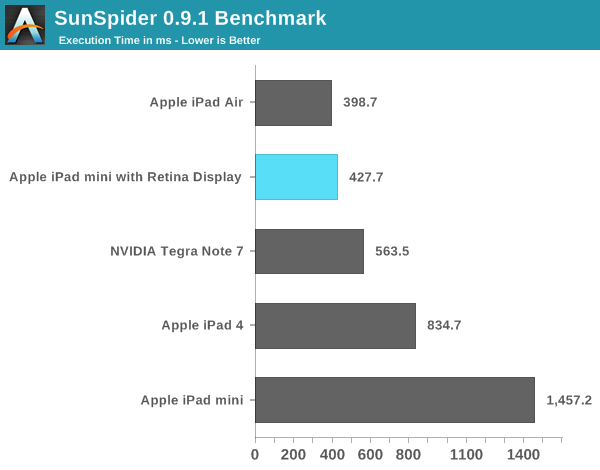

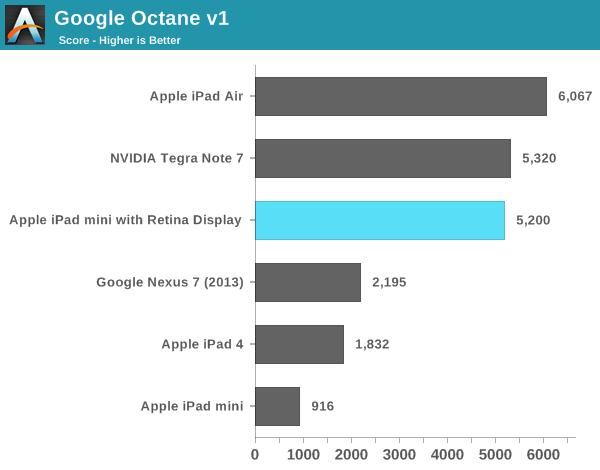
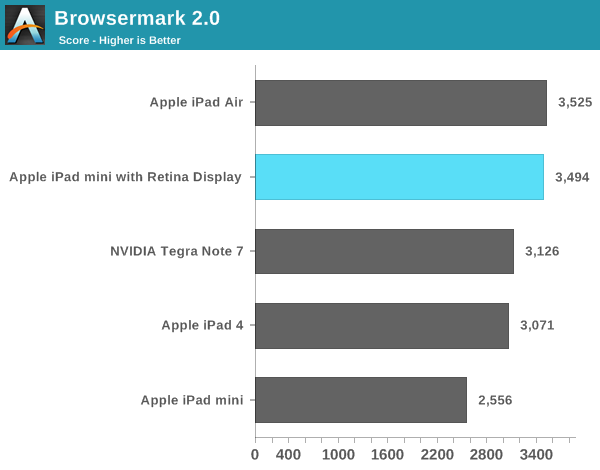
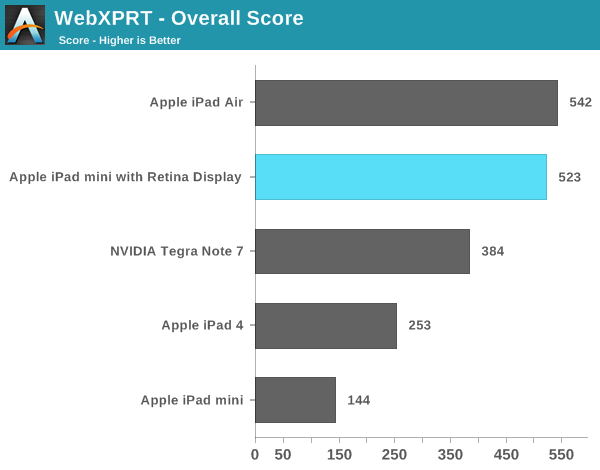
Compared to the first generation iPad mini, the new model is in a completely different performance league. Keep in mind the first mini used Apple’s A5 SoC based on an ARM Cortex A9. That’s the same single threaded performance as what’s in an iPhone 4S, and under iOS 7 it’s clearly running into some performance limits. The new mini with Retina Display however is a completely different animal. It’s fast.
Even comparing to the 4th generation iPad, the new mini is noticeably quicker.
Memory Bandwidth
Looking at the iPad mini’s memory bandwidth curve, we see it tracks very closely with that of the iPhone 5S. This is a slightly modified version of our previous bandwidth test, and you can see peak usable memory bandwidth (from the CPU’s perspective) of around 10GB/s. The ~12GB/s area right before you get out to main memory is bandwidth to the A7’s 4MB system-wide cache that sits after the shared L2 and the memory controller. This cache appears to service CPU, GPU and ISP requests at least.
GPU Performance
I believe the A7’s PowerVR G6430 GPU runs at around 450MHz. This frequency appears unchanged across all three A7 implementations. Once again, the big difference is how much thermal headroom exists in the platform which has an impact on overall performance.
Kishonti’s low level GPU performance tests back up my assertion that GPU frequency is fixed across all A7s. The iPad mini with Retina Display delivers equal performance to the iPad Air. The bigger news here is that nearly all of the GPU bound 3D tests seems to peg the mini and Air as equals. These are some pretty intense tests, but it looks like on the GPU side there’s no significant throttling when running at full tilt.
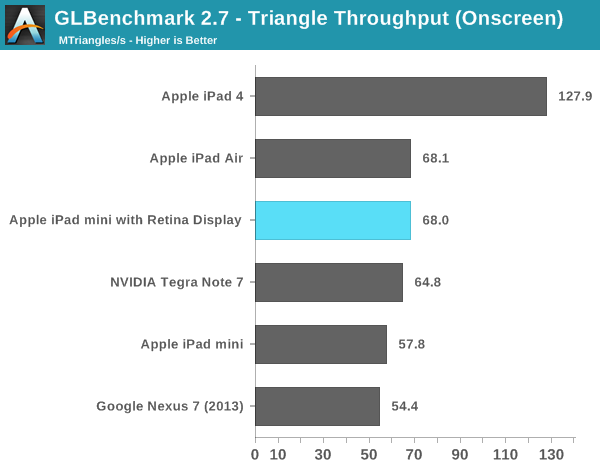

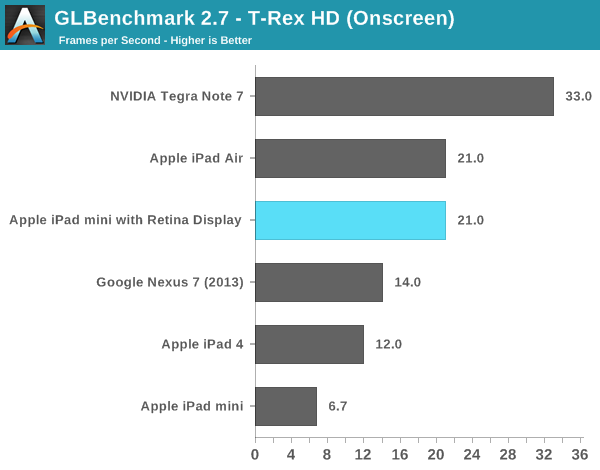

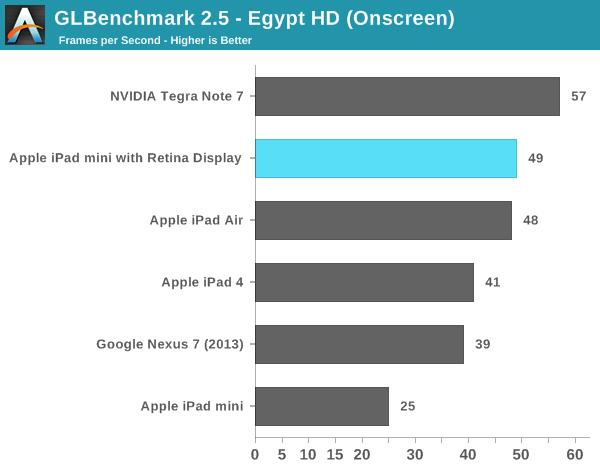
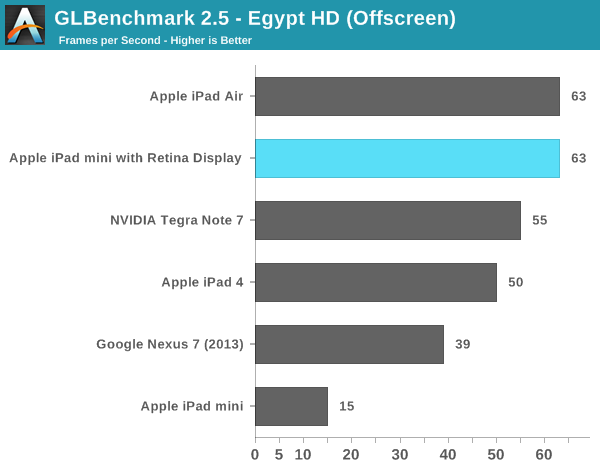
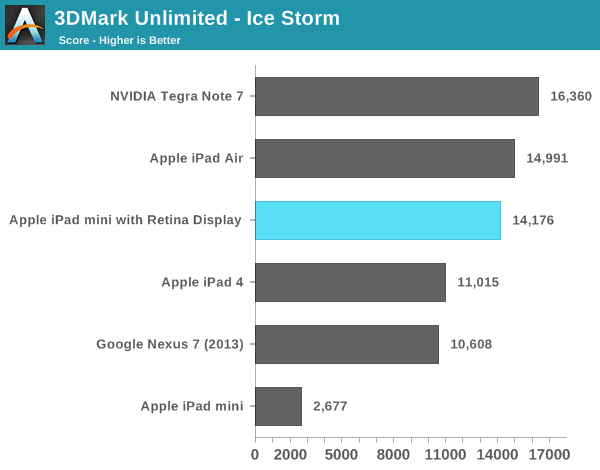
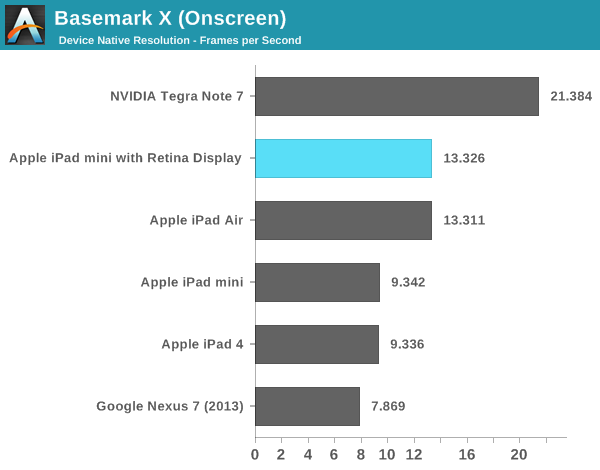
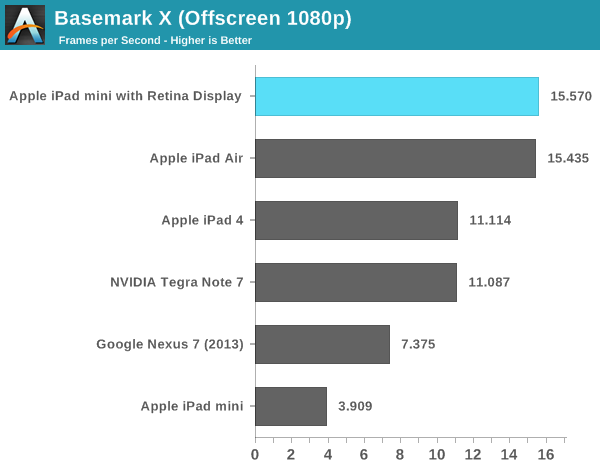
As I mentioned in our iPad Air review, despite having less peak theoretical memory bandwidth than the A5X/A6X, the A7 in the iPad mini never seems to regress in performance compared to even the iPad 4. Across the board the mini appears to be faster, more responsive and have more performance on tap than any prior iPad (big or small). The comparison to the original iPad mini is of course night and day. Even looking at lighter tests like the old GLBench Egypt HD benchmark, the iPad mini with Retina Display manages to be nearly twice as fast as the original mini - all while rendering 4x the number of pixels.


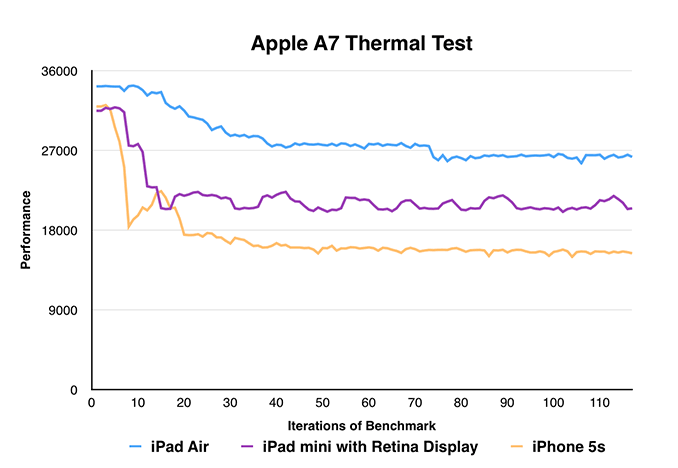
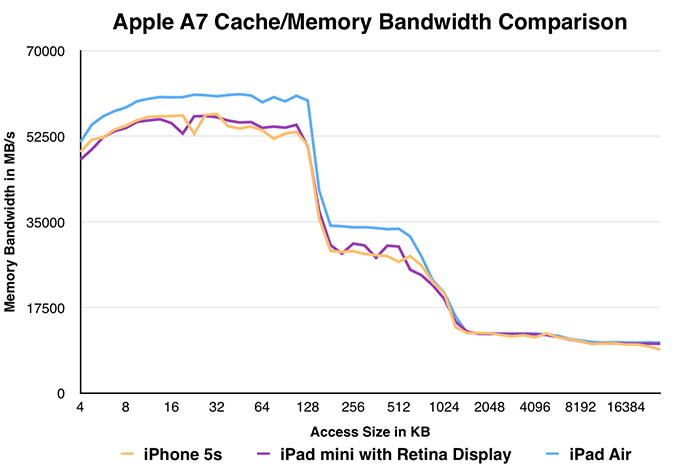








345 Comments
View All Comments
Daniel Egger - Saturday, November 16, 2013 - link
"1GB RAM for a 64-bit CPU of this calibre is also an insult"Nonsense, just because you need 2GB of RAM on Android to make it run smoothly doesn't mean that every vendor using a different OS needs to do the same.
"It will also mean that come IOS 8 or 9, it will likely be unuseable."
You clearly have no idea what you're talking about. Never in the history has Apple dropped the ball on delivering a decent user experience on older devices that quick. Also if you don't like the upgrade then don't upgrade...
Klug4Pres - Saturday, November 16, 2013 - link
Brian and Anand discussed low-memory issues on the latest gen Apple products in their recent live show - processes get killed off and Safari is a huge memory hog.Don't take my word for it - listen to the podcast. They also express disappointment with the 1GB RAM.
Puberticus - Saturday, November 16, 2013 - link
I agree if you're writing slop. But in this case, 1 GB is totally adequate. On the android side, not so much.ws3 - Saturday, November 16, 2013 - link
Why will an iPad Air or retina mini be "obsolete" within a year?Will they stop working? Will they stop getting OS updates?
Puberticus - Saturday, November 16, 2013 - link
Apple is not selling anything that's "too expensive."Where were you when the teacher talked about demand curves…?
RadarTheKat - Monday, November 18, 2013 - link
Have you ever priced BMW wheels? We;come to the real world!stringstream - Saturday, November 16, 2013 - link
I'm seeing the first page notes the old iPad Mini still starts at $329 - I believe it starts at $299 now.Elwe - Saturday, November 16, 2013 - link
Agreed; the base model is now priced at $299.Abelard - Saturday, November 16, 2013 - link
I bought an iPad mini last year. I'm happy with my purchase, even though the screen is kinda grainy. This new display looks killer, though.andy o - Saturday, November 16, 2013 - link
Goddamit, generally speaking I'm an Android guy, but been eyeing the mini cause of the power and iOS is just simply better at audio recording. But the prices are all over the place. $100 for a 16GB increase, and also for a 64GB increase? $130 for cellular connection? Oh, and if you want GPS and compass, have to pay that $130.